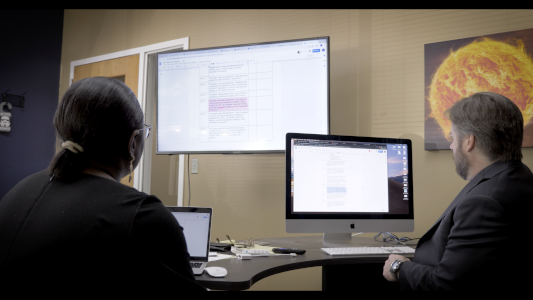
Anytime change happens, people get emotional. The world seems consumed in chaos. This is particularly true when it comes to IT implementations. For over 25 years, I’ve seen and been a part of many system implementations and worn many hats in the process. Many didn’t go smoothly and some of them just flat out failed. That’s millions of dollars and work hours down the drain! What’s crazy is that there isn’t one single issue that leads to an implementation project’s collapse, there are eight major causes.
New IT implementations come with a fair share of risks, but the truth is that implementation projects primarily fail due to a combination of poor planning and miscommunication. The business itself often lets IT implementations fail. However, this also means that you have the power to guide their success. Let’s count down to the number one reason for IT implementation failure and examine how you and your team can overcome these eight pitfalls.
Newsletter sign up
"*" indicates required fields
8. Your Project is Too Big
Sometimes IT implementations fail because they are just too complicated. Since 1998, the U.S Navy lost over $1B on implementing four ERP systems, which failed. The costs and variables involved in the massive projects were just too much to manage. Over scaling your implementation project is a serious threat and will be hard on both your staff and your budget. Constantly seeking perfection in the implementation will stall progress and lead to inevitable dysfunctions.
The Fix: Scale Moderately
The software needs to work, it doesn’t need to be perfect, improvements can be made over time. You may have big ambitions and goals for your company, but innovation is a process. Implementing new software is a challenge, don’t make it harder than it needs to be. Instead, plan your implementation conservatively so that you have more control over the timeline and factors of the process. Scope the project into smaller achievable chunks instead of one massive undertaking.
Start by getting statements of work for the implementation that are in the 4-8 week time frame. Apply this as an Agile methodology too, in a multiple of two weeks. Remember, if you accomplish implementation milestones ahead of schedule and are adopting the tech well, you can always accelerate your plans. Don’t risk your project being too ambitious! Be practical. Be sure to monitor your team’s skills and the rate of progression. If the budget is draining and projects are hitting roadblocks, scale down, reevaluate, and adjust your approach for success.
7. Deficient Features (Unmet Requirements)
One of the most frustrating, expensive, and embarrassing reasons why IT implementations fail is because the desired features a company wanted in the new system can’t be supported. The main reason this issue occurs is a lack of preparation during the selection of a new IT tool.
Features are the qualities of the software being implemented – what you need the software to do. If the software can’t perform the desired requirements, the company is just wasting money. If the system can’t be modified or supplemented to compensate for feature gaps, the business won’t be able to progress or even do its work effectively. The new tool that was going to help revolutionize the business process is now an ineffective waste. As the software turns out to be incompatible with the business, or too difficult to operate, the company will abandon the implementation.
The Fix: Map Out Your Requirements
In order to gain the best use out of any software, you need your requirements met. This means compiling detailed requirements in a document thoroughly outlining what the features need to accomplish and how. Key stakeholders should give their insight and help build the requirements list to ensure that the system will be fully applicable and efficient. As a bonus, this is also a good way to get staff excited about the implementation. Additionally, you get to see the skill sets you’re working with while also preparing your team for the implementation.
The requirements you document then becomes your guide. As you research software and meet with IT representatives, you should be able to confirm whether the product will accommodate your requirements.
Ensure your software requirements will be met by looking for flexible IT solutions. Choose an IT platform that is highly configurable and customizable with a strong API. Overall, these qualities give you enhanced control over how the solution can be used for your individual business.
Avoid an IT platform with no API or an API that can’t be automated. This will disrupt your processes and threaten integrations to other software. The lack of automation will also force you to do a lot of work manually, not only disruptive to your workflow, but also a threat to data accuracy.

6. Deprioritization
It’s normal to have deadlines or issues come up that require attention away from key initiatives. This is yet another reason why implementations fail: when the implementation is just deprioritized and takes a backseat to other tasks. If you and your staff are not committed to the implementation process, it won’t come to fruition. Deadlines will be missed, requirements will be lacking, and projects will fall behind. You’ll be wasting time and money, and your business won’t gain the implementation you desired.
The Fix: Stick to the Plan!
Choosing a new IT product and outlining a plan is useless if you’re not going to follow-through. When you have a change management plan, you need to establish deadlines, deliverables, and key performance indicators to measure progress. Your team needs to be committed to the plan to keep the implementation on schedule. Besides the plan itself, it’s also important to emphasize the importance and value of the implementation to motivate your team.
5. Budget Isn’t Adequately Scoped or Managed
IT implementations require a considerable monetary investment. However, many implementations have failed because the budget wasn’t scaled appropriately. This, coupled with poor financial management means that the implementation simply becomes too expensive to handle and is abandoned. If this is the case, then the effort is a total waste of money with no return on investment.
There are several ways the budget can be mishandled in implementations. One common mistake is to spend excessive amounts of the budget on edge cases, getting so focused on one area of the project that you run out of funding for other components. Budgeting based purely on time and materials instead of a fixed budget also contributes to rapid budget drain.
All of these cases usually involve minimal or inconsistent budget oversight. Arguably the biggest budget mistake is not having dedicated oversight of the project’s financial health. Without a group or individual adamantly monitoring the budget, progress, and requirements, the entire project simply runs out of resources to be completed.
The Fix: Budget for the Unexpected, Manage Thoroughly
IT implementations involve a lot of factors that can change rapidly. Don’t fear the unexpected, plan for them by allowing significant room in your budget for your project. A good rule of thumb in your initial plan is to over-budget for the project by 20%. This gives you much needed financial flexibility that you can allocate as need requires. If you don’t use all of the funds for the implementation, that’s a plus but, but if you find expenses mounting, this extra budget will give you a cushion.
You’ll also want to assign someone (or a team) to monitor the implementation budget. It’s mission-critical that you have real-time awareness of budgetary statuses to ensure the implementation remains on track. Relying on a collaborative accounting system will help you and your teams be aware of how the project is progressing and the effect of efforts on the budget. This awareness will help you adjust strategies and conserve the budget to make the best decisions for the implementation possible.
4. Incompetence
All too often, IT implementations fail because people just don’t know what they’re doing, or are unable to adjust to the needs of the project. Incompetence can be felt at all levels and times within a company. However, IT implementations require so much precision and planning that incompetence issues tend to really come to the surface during this transition. There are several forms of incompetence in this regard. There have been some cases where leaders or employees don’t actually grasp the purpose of their role, which inhibits the implementation severely and causes office friction.
Incompetence becomes clear when leadership or employees simply don’t have the skill sets needed to adjust to the new technology. They may have been trained in a totally different system and are just unfamiliar with the requirements needed to bring on the newest IT system. It’s also important to recognize that incompetence can also be felt in the implementation partner, particularly if they’re spearheading efforts with inexperienced staff.
The Fix: Lead with Competent Staff
It’s vital for you to assess the skills of your team before the implementation begins. Interview them to gauge how they will conduct the implementation objectives. If your conversations get a lot of ‘I don’t know, it’s always been done this way’ answers or if their reasoning is ‘because this person needs it done this way,’ these indicate they don’t know what they’re doing, or why. Implementing new technology is a strategic investment to maximize your work processes. You can’t implement IT properly if your staff can’t grasp how their role is designed to enable and adjust to this process.
You should also be observing how well they perform their roles, lead and work with staff, and adapt to situations. These are major competency indicators. Vendor management is also crucial for making sure that the implementation goes smoothly. In your contract, make sure you’re working with fully qualified and experienced people.
Management can also invest in training their staff on the new technology to help bridge incompetency gaps. While this won’t necessarily solve all incompetence issues, it can help teams adjust faster. Remember, investing in IT knowledge will ultimately impact your whole business going forward by helping staff adopt the new tech much faster and easier.
3. Dysfunctions
IT implementations inevitably encounter some amount of dysfunction, even when you have willing and capable staff. This is normal to a degree because people are still learning the technology and adjusting to new processes. The danger here is when dysfunctions escalate into stalling and ultimately derailing workflow and teamwork. Such dysfunctions usually occur when teams are ushering too many incremental changes, the result of poor planning, or a lack of definitive decision making.
Dysfunctions are also commonly rooted in trying process re-engineer systems around the limitations of employees or the prior system. This can completely undermine the new innovations of the system being implemented, forcing it to be altered too much past usefulness. This can take more time and money to accommodate and lead to mounting dysfunctions in the process. As dysfunctions mount, people may shrug off accountability and commitment altogether, leading to poor preparation and projects.
This can all generate an emotional overload that just taxes the efficiency of the project. People get so frustrated by dysfunctions that the company will just abandon the implementation.
The Fix: Empower Ownership
C-suite executive leadership needs to be the guiding light during this time. In addition to making a comprehensive change management plan, you need to empower your teams to own the process. You’ll need to outline clear decision-makers who will act efficiently to secure a fluid implementation.
Acknowledge the difficulty of changing from the old system to the new system. Staff needs to be assured that it’s okay to make mistakes during these times but not blame each other or the technology. Establishing a clear schedule and deliverables will also help everyone remain on target and avoid confusion. Leaders must be decisive and timely.
2. Politics
Office politics can be a major detriment to IT implementations because it can lead to in-house fighting and bitterness which can jeopardize progress. One party might even try to sabotage the project because they don’t want the IT implementation. All of this undermines the cooperation needed to achieve the project. The IT implementation will simply crumble due to in-house fighting. The company becomes so focused on security and status, they lose sight of the value of a new IT system.
The Fix: Be Aware and Neutralize Politics
Upper management needs to be aware of the company culture and work to mitigate political issues team members might have. Stamp out the politics! Encourage a collaborative work environment and affirm that all of your staff are valuable to the company and the project. This helps ensure that no one feels superior to another. It’s also important to promote leaders who can see signs of political strife and work to keep the implementation on track.
While you want to avoid competition, you should still appoint a primary leader to spearhead the overall implementation. You’ll want someone who has a clear vision of the process and will be able to identify and mitigate politics when they threaten progress. This also gives you a focused approval process to keep the project on track.

1. Change Management
It’s important to understand that IT implementations are usually difficult to orchestrate. This doesn’t make implementations impossible, they happen all the time, but there are a lot of ways the project can be derailed. Poor change management is the top, overarching reason these projects fail. Here are the major areas where change management breaks down:
- Company communications
- Project management
- User acceptance
- Time over regular job
- People
Change is exactly how it sounds, it’s something new. In an IT implementation, people are facing new processes, even new mindsets on how to approach their work. The technology is actually reengineering the business process, so they can’t do their job exactly how they used to. People are naturally going to be afraid of straining to learn a new system or losing a functionality they previously relied on. The new skills they’ll need to learn takes time to hone which can add to the time they already putting into work, generating frustrations. This can cause tension and threaten user acceptance of the new system altogether.
In the chaos, project deadlines can slip and requirements can be unmet or ignored through faltering communication. Budget issues can arise because of this. All of these factors disrupt the implementation and drain time and resources.
The Fix: Embrace Change, Plan Well!
The implementation needs to take priority. You simply can’t build success as a plate spinner. While staff should still perform essential tasks, implementation initiatives need to take priority. As you prepare change management plans, make sure to address each of the points mentioned above. Keep everyone focused on the prize and assuage fears.
IT implementations require the executive-level leaders to step up and engage in the process. They need to inform staff that this change is purposeful and meant to be a positive thing. It’s not meant to alienate anyone or cause extra hassle. Instead, this is an opportunity to reach new heights for the company, together. Make this a positive event.
Don’t just spring the change on staff, people need to made aware that the change is happening well in advance. This is also a time to inform people how the change will affect and ultimately improve the work process. Reasonable expectations should be established too, with the understanding that things may take longer as people adapt to the system. Adjustments will be made over time, there’s no need to over-stress.
Conclusion
So yes, there are several reasons why IT implementations can fail – BUT – there are also eight solutions for these eight issues. At the end of the day, you and your team control the implementation. You can orchestrate the process and course-correct the implementation when you need to. Plan well, be proactive, and you can pull off a smooth implementation.
For more free accounting resources, read on:
- Best Accounts Receivable Software
- Best Financial Dashboards for Making Business Decisions
- Benefits of Automating Accounting Processes
- Best Vendor Payment Processes
- What is Integrated Accounting Software? Everything to Know
- Small Business Accounting Tips: Improving Your Business’ Workflows
- Guide to Project Accounting: Everything You Need to Know
- Financial Management Options on Salesforce
- Balance Sheet Reporting: Everything You Need to Know
- How to Make Business Financial Statements
- Does My Accounting Software Meet DCAA Compliance
- 5 Steps for Annual Reporting
- SalesForce Financial Management Options
See Accounting Seed in action
Get a close-up view of how accounting on Salesforce can eliminate the need for costly integrations—and silos of mismatched information—by sharing the same database as your CRM.



